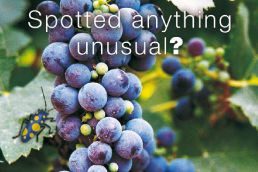 Dried Fruits Australia represent the biosecurity interests of grape growers of the dried fruit industry. They are members of Plant Health Australia and signatories to the Emergency Plant Pest Response Deed. Their responsibilities include:
Dried Fruits Australia represent the biosecurity interests of grape growers of the dried fruit industry. They are members of Plant Health Australia and signatories to the Emergency Plant Pest Response Deed. Their responsibilities include:
- biosecurity planning and implementation at the national and farm levels
- liaising with federal and state governments on trade issues
- funding and supporting biosecurity initiatives
- participating in national committees and response efforts in an emergency.
Industry overview
In Australia, grapes for the dried fruit industry are predominantly grown in the Sunraysia region which spans north western Victoria and south-west New South Wales around the Murray River, and also in the South Australia Riverland.
Biosecurity plans, manuals and resources
Expand
 Biosecurity Plan for the Viticulture Industry
Biosecurity Plan for the Viticulture Industry
Biosecurity planning provides a mechanism for the viticulture industry, government and other relevant stakeholders to assess current biosecurity practices and future biosecurity needs. Planning identifies procedures that can be put in place to reduce the chance of pests reaching our borders or minimise the impact if a pest incursion occurs.
The Biosecurity Plan for the Viticulture Industry outlines key threats to the industry, risk mitigation plans, identification and categorisation of exotic pests and contingency plans. For a copy, please contact PHA on 02 6215 7700 or email biosecurity@phau.com.au.
Biosecurity Manual for Viticulture Industry
Vineyard Biosecurity Manual
The Vineyard Biosecurity Manual contains information to help producers to implement biosecurity on-farm. Manuals usually contain an overview of biosecurity, fact sheets to identify the high priority pests of a crop, tips on crop management, and how to manage people, vehicles and equipment to minimise biosecurity risks. Manuals also contain a biosecurity self-assessment list, and templates to record pest surveillance records and visitors.
More information about on-farm biosecurity for both plant and livestock producers is available from the Farm Biosecurity website.
Promotional item to support the exotic plant pest hotline 1800 084 881
Pests Expand
Exotic pests (not in Australia)
The following is a list of high priority exotic pests of grapes. These pests were identified during the development of the Biosecurity Plan for the Viticulture Industry in consultation with industry, government and scientists. They have been assessed as high priority pests based on their potential to enter, establish, and spread in Australia (eg environmental factors, host range, vectors) and the cost to industry of control measures.
PHA has a range of fact sheets, contingency plans and diagnostic protocols relevant to these pests. Pest risk review documents are also available for some pests. Please contact PHA on 02 6215 7700 or email biosecurity@phau.com.au for more information.
Endorsed National Diagnostic Protocols are available from the National Plant Biosecurity Diagnostic Network webpage.
| Common name | Scientific name | EPPRD Category | Fact sheet | Contingency plan | Diagnostic protocol |
|---|---|---|---|---|---|
| American berry moth | Polychrosis viteana | FS | |||
| Black rot | Guignardia bidwellii | 3 | FS | DP | |
| Bois noir | Candidatus Phytoplasma solani | FS | |||
| Brown-marmorated stink bug | Halyomorpha halys | FS FS FS | CP | ||
| Carambola fruit fly | Bactrocera carambolae | FS FS FS FS | DP DP | ||
| Comstock’s mealybug | Pseudococcus comstocki | FS | |||
| Grapevine red blotch virus | Grapevine red blotch virus | FS | |||
| Khapra beetle | Trogoderma granarium | 2 | FS FS | CP | DP |
| Orange tortrix | Argyrotaenia citrana syn A. franciscana | FS | |||
| Pierces disease | Xylella fastidiosa | 2 | FS FS FS FS FS | CP CP | DP |
| Spotted lanternfly | Lycorma delicatula | FS | |||
| Spotted wing drosophila | Drosophila suzukii | FS FS FS FS |
Other pests
The following is a list of documents for other exotic and endemic pests of grapes. Please note that this is not a complete list of pests: rather it includes pests for which documents exist in the Pest Information Document Database.
Some of the documents presented here are not tailored to the dried fruit industry and are included for information only.
| Common name | Scientific name | EPPRD Category | Fact sheet | Contingency plan | Diagnostic protocol |
|---|---|---|---|---|---|
| Angular leaf scorch | Pseudopezicula tetraspora | FS | |||
| Angular leaf spot | Mycosphaerella angulata | FS | |||
| Bacterial blight of grapevine | Xylophilus ampelinus | FS | |||
| Banana spider mite | Tetranychus piercei | 4 | FS FS | ||
| Brown rot | Monilinia fructigena | 3 | FS FS FS | ||
| Cassava spider mite | Tetranychus truncatus | FS | |||
| Citrus blackfly | Aleurocanthus woglumi | FS | |||
| European grapevine moth | Lobesia botrana | FS | |||
| False codling moth | Thaumatotibia leucotreta syn Cryptophlebia leucotreta | 2 | FS | CP | |
| Glassy-winged sharpshooter | Homalodisca vitripennis | FS FS FS FS FS FS FS | CP CP | ||
| Grapevine leaf rust | Phakopsora euvitis | 3 | FS | ||
| Grape mealybug | Pseudococcus maritimus | FS | |||
| Grape phylloxera | Daktulosphaira vitifoliae (exotic strains) Type B | 3 | FS | CP | |
| Japanese beetle | Popillia japonica | FS | |||
| Mediterranean fruit fly | Ceratitis capitata | FS | DP | ||
| Omnivorous leaf roller | Platynota stultana | FS | |||
| Oriental fruit fly | Bactrocera dorsalis | 2 | FS FS FS FS FS FS FS | DP | |
| Natal fruit fly | Ceratitis rosa | FS | DP | ||
| Orange tortrix | Argyrotaenia citrana syn A. franciscana | FS | |||
| Pacific spider mite | Tetranychus pacificus | FS | |||
| Queensland fruit fly | Bactrocera tryoni | FS | DP | ||
| Raspberry ringspot virus | Raspberry ringspot virus (Nepovirus) | FS | |||
| Rotbrenner | Pseudopezicula tracheiphila | FS | |||
| Strawberry spider mite | Tetranychus turkestani | FS | |||
| Texas root rot | Phymatotrichopsis omnivora (syn Phymatotrichum omnivorum) | 2 | FS FS | ||
| Tomato black ring virus | Tomato black ring virus (Nepovirus) | FS | |||
| Western flower thrips | Frankliniella occidentalis | FS | |||
| Vine mealybug | Planococcus ficus | FS |






Recent Comments